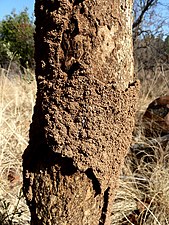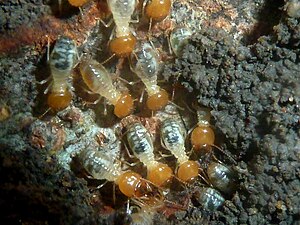Odontotermes
| Fungus-growing termites | |
|---|---|

| |
| The alate, soldier, minor worker and queen of O. horni | |
| Scientific classification | |
| Kingdom: | Animalia |
| Phylum: | Arthropoda |
| Class: | Insecta |
| Order: | Blattodea |
| Infraorder: | Isoptera |
| Family: | Termitidae |
| Genus: | Odontotermes Holmgren, 1912 |
Odontotermes, commonly known as the fungus-growing termites, is a termite genus belonging to family Termitidae, which is native to the Old World. They are most destructive in wooden homes,[1] and are agricultural pests in the tropics and subtropics of Africa and Asia.[2] It is the most diverse termite genus in Africa, with 78 species recorded (as of 2002).[3]
Nests[]
Their underground nests form a slight mound above ground, which may be covered in grass.[1] In large colonies, the mounds may be up to 6 m (20 ft) in diameter, and may be covered by shrubs and trees. Some species construct open chimneys or vent holes that descend into the mound. The fungal garden is enveloped by a thick layer of clay.[1]
Castes[]
The queen is imprisoned in a clay cell in the midst of the fungal garden at the center of the hive. The African species have a single soldier cast, unlike the related genus Macrotermes.
Food[]
Their only food is the fungus grown in the fungal garden at the center of the nest. The fungus is cultivated on a substrate of wood, bark, leaf litter, dry dung, and dead grass.[1] These are plastered with cement where they are obtained, which facilitates diurnal foraging. Odontotermes species are major contributors to litter decomposition.[2] The fungus Termitomyces reticulatus is found in association with and in Africa.[4]
Species[]
Species include:
- Odontotermes assmuthi Holmgren, 1913 – South Asia
- (Haviland, 1898) – Africa
- Odontotermes ceylonicus (Wasmann, 1902) – South Asia
- Odontotermes escherichi Holmgren, 1911 – South Asia
- Odontotermes feae (Wasmann, 1896) – South Asia
- Odontotermes formosanus (Shiraki) – South Asia
- Odontotermes globicola (Wasmann, 1902) – South Asia
- Odontotermes horni (Wasmann, 1902) – South Asia
- Odontotermes koenigi (Desneux, 1906) – South Asia
- (Haviland, 1898) – Africa
- Odontotermes obesus (Rambur) – South Asia
- Odontotermes preliminaris (Holmgren, 1911) – South Asia
- Odontotermes redemanni (Wasmann, 1893) – South Asia
- Odontotermes taprobanes (Walker, 1853) – South Asia
- (Sjöstedt, 1902) – Africa
- Wasmann – South Asia
Gallery[]

O. badius worker

Cement plastered over tree bark

Workers foraging on tree bark under cement

Workers in ventilation tunnel
References[]
- ^ a b c d Picker, Mike; et al. (2004). Field Guide to Insects of South Africa. Cape Town: Struik Publishers. p. 56. ISBN 978-1-77007-061-5.
- ^ a b Chiu, Chun-I; Yeh, Hsin-Ting; Li, Pai-Ling; Kuo, Chih-Yu; Tsai, Ming-Jer; Li, Hou-Feng (17 September 2018). "Foraging phenology of the fungus-growing termite Odontotermes formosanus (Blattodea: Termitidae)". Environmental Entomology. 47 (6): 1509–1516. doi:10.1093/ee/nvy140. PMID 30239668.
- ^ Muvengwi, Justice (2017). "Relationships between termite (Macrotermes) mound distribution, plant diversity and large mammalian herbivory patterns in Gonarezhou National Park, Zimbabwe". hdl:10539/22729.
{{cite journal}}: Cite journal requires|journal=(help) - ^ van der Westhuizen GCA; Eicker A. (1990). "Species of Termitomyces occurring in South Africa". Mycological Research. 94 (7): 923–37. doi:10.1016/S0953-7562(09)81306-3.
- Termite genera
- Insects of Africa
- Insects of Asia
- Insect pests of millets



